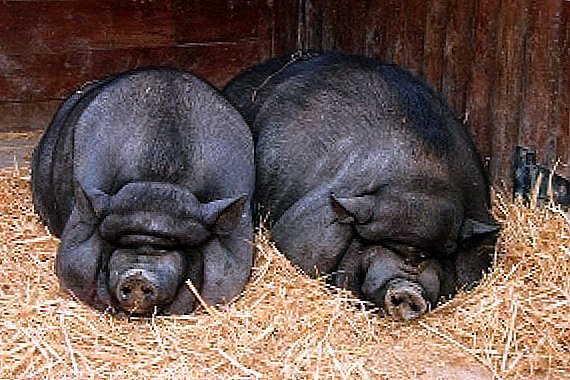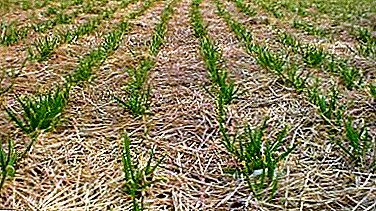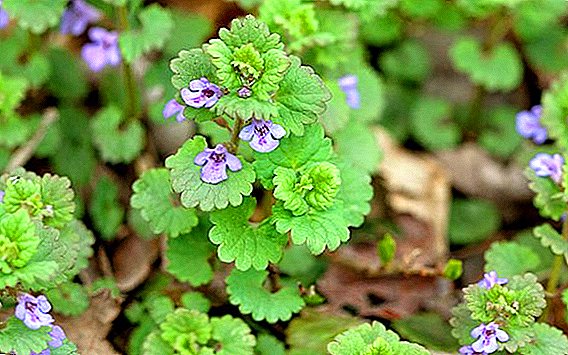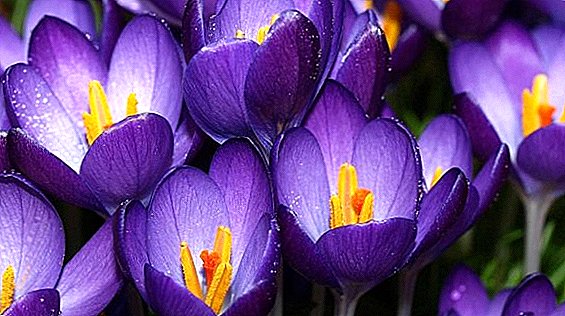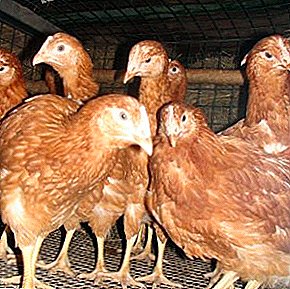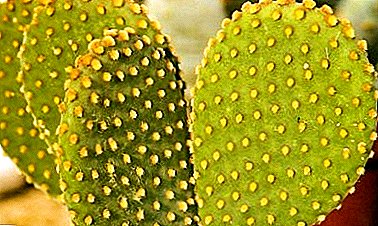 For the normal development of any plant, three nutrients are necessary: nitrogen, phosphorus and potassium. Nitrogen contributes to their growth and fruiting, phosphorus accelerates development, and potassium helps garden crops to overcome stress in the form of adverse conditions, to cope with diseases, to bring high-quality and long-stored crops. Potassium-containing fertilizers include potassium sulfate, ash, potassium salt and potassium chloride. On the latter and will be discussed in this article.
For the normal development of any plant, three nutrients are necessary: nitrogen, phosphorus and potassium. Nitrogen contributes to their growth and fruiting, phosphorus accelerates development, and potassium helps garden crops to overcome stress in the form of adverse conditions, to cope with diseases, to bring high-quality and long-stored crops. Potassium-containing fertilizers include potassium sulfate, ash, potassium salt and potassium chloride. On the latter and will be discussed in this article.
Description and physico-chemical characteristics of potassium chloride
Potassium chloride is in the form of small cubic gray-white crystals or a red powder without odor with a salty taste.
As a chemical inorganic compound has the formula KCl (potassium salt of hydrochloric acid). Molar mass - 74.55 g / mol, density - 1988 g / cu. cm.
Slightly soluble in water: in 100 ml with zero temperature - 28.1 g; at +20 ° C - 34 g; at +100 ° C - 56.7 g. The aqueous solution boils at a temperature of 108.56 ° C. Melting and boiling processes occur without decomposition.  For use in agriculture, potassium chloride granulated, coarse and fine crystalline is produced. Granulated is a pressed granules of white color with a gray tinge or red-brown color. Coarse-crystalline - large crystals of white-gray color, small - small crystals or grains.
For use in agriculture, potassium chloride granulated, coarse and fine crystalline is produced. Granulated is a pressed granules of white color with a gray tinge or red-brown color. Coarse-crystalline - large crystals of white-gray color, small - small crystals or grains.
In agricultural technology, it is preferable to use potassium chloride in granules and large crystals, since it is in this form that they have a longer effect, dissolve more slowly and are washed away by sediments.
Depending on the method used to make the fertilizer, it may contain from 52 to 99% of potassium.
Did you know? In addition to agriculture, KCl is used in the food industry. There it is known as the food additive E508. Potassium chloride is also applicable in various industries and in pharmacology, for which it is produced in powder form. In several US states, prisoners inject him into executing the death penalty.
Signs of deficiency and excess of potassium in plants
We offer to understand why we need potassium chloride. It has the following positive effects:
- increasing the immunity and resistance of plants to drought, temperature fluctuations, low temperatures;
- increased immunity to various diseases: powdery mildew, rot, rust;
- strengthening and hardening of the stems, the formation of their resistance to lodging;
- fruiting better quality yield - in size, taste and color;
- stimulation of seed germination;
- increase the shelf life of vegetables, berries, fruits, grains.
 On average, agricultural plants consume potassium in such quantities:
On average, agricultural plants consume potassium in such quantities:
- grain - 60-80 kg per 1 ha;
- vegetables - 180-400 kg per 1 ha.
Did you know? Potassium is best absorbed by soil acidity of 5.5.-7 pH.The fact that the plant lacks this element will be indicated by the following symptoms:
- leaves are dull, pale, with blue, often bronze tint;
- light rim around the leaflet, which later turns brown and dries out (regional burn);
- brown spot on the leaves;
- curling the edges of the sheets;
- thin stem and shoots;
- growth retardation of the whole plant;
- no flowering or ejection of small buds;
- active growth of stepsons;
- the appearance of chlorotic spots on the lower leaves and interstitial chlorosis;
- development of fungal diseases.
Nitrogen - the main element of plant life, it affects the growth and metabolism of crops. To improve the yield of plants using nitrogen fertilizers: urea, ammonium nitrate, potassium nitrate.
 The plant will signal an excess of potash fertilizers with the following changes:
The plant will signal an excess of potash fertilizers with the following changes:
- slower growth and development;
- releasing small young leaves;
- darkening of old leaves;
- the appearance of brown spots on the lower leaves;
- the extinction of the ends of the roots.
Application of potassium chloride in agriculture
Potassium chloride has found application in agriculture throughout the world. It is used as the main fertilizer, introduced into the land for plowing and for cultivation (on light soils). It is also part of complex fertilizers.
Kalii chloridum is approved for use on all types of soil. It is well dissolved in a soil solution.
The main introduction should fall in the autumn period. In May, pre-sowing is carried out, and during the growing season, from June to August, as a top dressing. The application must be carried out after heavy irrigation or rain.  Many plants can negatively respond to the addition of potassium chloride, since chlorine is included in the fertilizer. Chlorophobic cultures include:
Many plants can negatively respond to the addition of potassium chloride, since chlorine is included in the fertilizer. Chlorophobic cultures include:
- potatoes;
- grapes;
- tobacco;
- berry bushes;
- legumes.
A period of heavy rainfall, which will wash chlorine from the top layer of soil, while potassium remains in it, can neutralize harm from chlorine.
Important! It is best to apply fertilizer for chlorophobic cultures in autumn. Before the planting period, chlorine will already be washed out of the ground. Otherwise, potash supplements should be made with fertilizers that do not contain chlorine, for example, potassium sulfate or potassium magnesia.The plants that are less sensitive to chlorine include beets (both sugar and fodder), sunflower, corn and a number of vegetables.
The most undemanding to potash feedings are cereals, legumes, cereals.
Potassium chloride fertilizer application rates
As we have already noted, the main application of fertilizer is carried out under the digging. Recommended standards - 100-200 g per 10 square meters. m. When making the spring rate should be reduced to 25-20 g per 10 square meters. m
Top dressing during the growing season is carried out using an aqueous solution. Fertilizer is very easy to prepare, as it usually dissolves easily in water. In 10 l of water is diluted with 30 mg of Kalii chloridum.  Experienced gardeners and gardeners prefer to feed in small quantities several times per season than once, but in large quantities. Next, we provide the recommended timeframes and application rates for supplements for different cultures:
Experienced gardeners and gardeners prefer to feed in small quantities several times per season than once, but in large quantities. Next, we provide the recommended timeframes and application rates for supplements for different cultures:
- potatoes - once in the autumn period, 100 g / 10 sq. m;
- tomatoes - once in the autumn period, 100 g / 10 sq. m (spring fed with potassium sulfate);
- cucumbers - twice during the growing season in a greenhouse, three to five times in open ground, 0.5 l per plant;
Important! In order not to harm the cucumbers, you should pre-feed several bushes. If after a few days no negative changes have occurred, and the plant's condition has improved, additional feeding can be carried out for the remaining cucumbers.
- Potassium chloride grapes are not fertilized, since one of the active ingredients - chlorine - can cause deterioration of the plant; potassium sulphate is used for this culture;
- fruit trees - during the fruiting period in the form of watering, 150 g per tree.
Kalii chloridum is also suitable for fertilizing flower crops.  Recommended terms and norms are as follows:
Recommended terms and norms are as follows:
- bulbous - in the flowering phase, 20 g / 10 l;
- small-onions - in the flowering phase, 10 g / 10 l;
- two-year and one-year - three times: in the period of growth (10 g / 10 l), in the budding phase (15 g / 10 l), during flowering (15 g / 10 l);
- curly - periods of growth, budding, flowering, 20 g / 10 l;
- roses - twice during growth, 20 g / 10 l;
- peonies - during flowering, 10 g / 10 l;
- gladioli - in the periods of the appearance of the third and fifth sheets of 15 g / 10 l; in the phase of formation of peduncle - 20 g / 10 l.
Precautions when working
As stated on the packaging of potassium chloride instruction, fertilizer refers to moderately hazardous (3rd class). It is not capable of damaging the skin when injected, but it irritates already existing wounds and inflammations. Therefore, it is recommended, if there are any on the body, to wear a protective suit before starting work on feeding.
The substance is not dangerous if released into the air at acceptable concentrations. However, the respiratory tract must be protected by a respiratory mask, and eyes - sealed glasses. It is prohibited to use lime, chalk or dolomite flour simultaneously with potassium chloride. Fertilizer does not apply to combustible and explosive, as well as contributing to corrosion substances. 
Storage conditions
According to the manufacturer's instructions, the fertilizer should be stored indoors with low humidity, where precipitation or ground water should not fall.
It is possible to store in the open, but only under a canopy, in well-closed containers or in bags of polyethylene.
The recommended shelf life is six months. After the expiration of this period, the substance does not lose its chemical properties. Changes may affect only the appearance and degree of friability.
In conclusion, we note that potassium chloride is among the most common fertilizers in agriculture. To his benefits should include the highest concentration of nutrient, ease of use and assimilation by the plant.
TO disadvantages - fertilizer is not suitable for all types of plant crops, since the chlorine content adversely affects their development. Kalii chloridum can be used as an independent feeding, and in mixtures with nitrogen, phosphorus and other fertilizers. When making his best result should be expected if you feed in small doses than once or twice as large doses.



